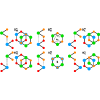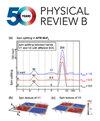Electronic band structure of high-symmetry homobilayers of transition metal dichalcogenides
IF 3.7
2区 物理与天体物理
Q1 Physics and Astronomy
引用次数: 0
Abstract
High-symmetric homobilayer transition metal dichalcogenides (TMDs) are important members of the bilayer (BL) van der Waals material family. Here we present a systematic study of the electronic band structure in low-energy regime in homo-BL TMD structures by using the standard method. Six types of BL TMD stacking configurations, which satisfy the symmetry are considered and they are , and . The intrinsic spin-orbit coupling (SOC) in the conduction and valence bands and the phase of interlayer hopping matrix elements are included in our investigation. Taking BL as an example, we examine the electronic energy spectra, the electron density of states, and the Fermi energies in these BL structures. We find that the electron energy dispersions in high-symmetric BL TMDs are not parabolic-like, where the band parameters (such as the energy gap, the effective electron band mass and the fourth-order correction coefficient in different subbands) depend markedly on the stacking configurations. Interestingly, the spin splitting in -stacked BL TMDs is suppressed because of center-inversion symmetry and time-reversal symmetry. Importantly, the phase of the interlayer hopping matrix element affects significantly the electronic properties of and stacked BL TMDs. The methodology and the results presented in this study can foster further exploration of the basic physical properties of BL TMDs for potential applications in electronics and optoelectronics.

过渡金属二卤化物高对称性同硅层的电子能带结构
高对称性同双层过渡金属二钙化物(TMD)是双层范德华材料家族的重要成员。在此,我们采用标准 k-p 方法,对同双层过渡金属二钙化物结构的低能态电子能带结构进行了系统研究。我们考虑了六种满足 C3 对称性的 BL TMD 堆叠构型,它们分别是 HMM、HXM、HXX、RMM、RXM 和 RMX。我们的研究还包括导带和价带的本征自旋轨道耦合(SOC)以及层间跳跃矩阵元素的相位。以 BL MoS2 为例,我们研究了这些 BL 结构的电子能谱、电子态密度和费米能。我们发现,高对称 BL TMD 中的电子能量色散并非抛物线状,其带参数(如能隙、有效电子带质量和不同子带的四阶校正系数)明显取决于堆叠构型。有趣的是,由于中心反转对称性和时间反转对称性,H 叠层 BL TMD 中的自旋分裂受到了抑制。重要的是,层间跳变矩阵元素的相位对 HXX 和 RMM 堆叠 BL TMD 的电子特性有很大影响。本研究提出的方法和结果有助于进一步探索 BL TMD 的基本物理性质,从而促进其在电子学和光电子学领域的潜在应用。
本文章由计算机程序翻译,如有差异,请以英文原文为准。
求助全文
约1分钟内获得全文
求助全文
来源期刊

Physical Review B
物理-物理:凝聚态物理
CiteScore
6.70
自引率
32.40%
发文量
0
审稿时长
3.0 months
期刊介绍:
Physical Review B (PRB) is the world’s largest dedicated physics journal, publishing approximately 100 new, high-quality papers each week. The most highly cited journal in condensed matter physics, PRB provides outstanding depth and breadth of coverage, combined with unrivaled context and background for ongoing research by scientists worldwide.
PRB covers the full range of condensed matter, materials physics, and related subfields, including:
-Structure and phase transitions
-Ferroelectrics and multiferroics
-Disordered systems and alloys
-Magnetism
-Superconductivity
-Electronic structure, photonics, and metamaterials
-Semiconductors and mesoscopic systems
-Surfaces, nanoscience, and two-dimensional materials
-Topological states of matter
文献相关原料
| 公司名称 | 产品信息 | 采购帮参考价格 |
|---|
 求助内容:
求助内容: 应助结果提醒方式:
应助结果提醒方式:


